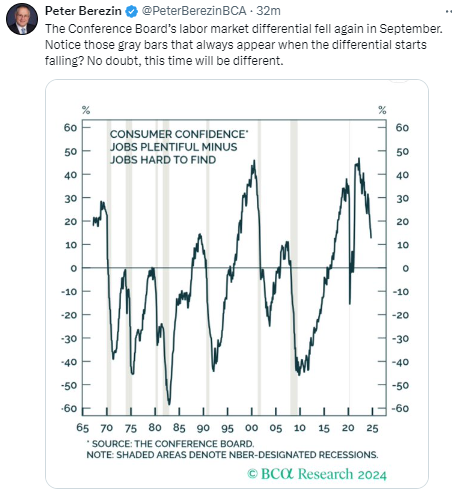9/24/2024
Yesterday’s move in our core allocation may turn out to have been more (near-term) timely (i.e., lucky) than we anticipated.
From our internal supporting narrative:
Now, while this is huge for Chinese equities today, suffice to say that the consensus among the economists we respect (enough to pay for their research) is that there’s clearly a tactical opportunity to game a near-term oversold bounce, but until China steps in with consumption-stimulating fiscal measures, their economy, and markets, will not see sustainable improvement.
So, while I get – and agree with (regarding the need for fiscal stimulus) – where these economists are coming from, I don't believe we should rule out the prospects for said fiscal stimulus to follow as we meander into next year.
On another note (of caution):
Peter Berezin points out, with a bit of facetiousness, how telling the consumer’s attitude toward his/her job prospects can be about go-forward economic prospects (gray bars = past recessions):

“Reducing our exposure to US staples and healthcare reflects marginally better odds of a soft-landing based on the Fed’s aggressive start to the easing cycle, and recent improvement in the PWA Index… However, our base case remains that recession odds are better than 50/50 on a 6-12 month horizon… Therefore, despite the cuts, staples and healthcare remain top weightings, as do cash (t-bills) and gold.Well, I guess I should've said next 12 hours... They stepped up last night… Here are the details (HT P. Boockvar):
Increasing our emerging mkt equity exposure reflects the improved prospects for a near-term weaker-trending dollar, as well as China’s historically-weak valuations and the likelihood of Chinese policymakers to be forced to step up the stimulus over the next 12 months.”
1)The PBOC cut its reserve requirement ratio to 9.5% from 10%, which is estimated to free up about 1 trillion yuan (about $140b) in fresh lending.The PBOC also made it clear that more easing is to come.
2)The PBOC cut the 7 day reverse repo rate to 1.50% from 1.70%.
3)There was a 50 bp drop on the average interest rate paid on existing mortgages.
4)There was a cut in the minimum downpayment to buy any home (even a 2nd one) to 15%.
5)The PBOC is creating a 500b yuan swap facility which would lend money to funds, insurers and brokerage firms to use to buy stocks.
6)There is also another re-lending facility of 300b yuan given to commercial banks that would in turn lend the money to companies and other entities for stock buybacks.
Now, while this is huge for Chinese equities today, suffice to say that the consensus among the economists we respect (enough to pay for their research) is that there’s clearly a tactical opportunity to game a near-term oversold bounce, but until China steps in with consumption-stimulating fiscal measures, their economy, and markets, will not see sustainable improvement.
So, while I get – and agree with (regarding the need for fiscal stimulus) – where these economists are coming from, I don't believe we should rule out the prospects for said fiscal stimulus to follow as we meander into next year.
Last night’s announced measures definitely offer up the potential oomph to propel Chinese equities notably higher over the next several weeks (maybe months), and we also should not entirely dismiss the potential for the resulting animal spirits to move the needle, albeit slightly, for the real economy as well.
On another note (of caution):
Peter Berezin points out, with a bit of facetiousness, how telling the consumer’s attitude toward his/her job prospects can be about go-forward economic prospects (gray bars = past recessions):
And another:
I.e., what matters most in terms of gauging the go-forward outlook – that’d be new orders – fell at the fastest clip since December ‘22… That’s, let’s say, not good!
Compound the new orders malaise with the employment component falling at a pace not seen since June ‘20, and, well, that’s really not good!
Services (PMI scoring an expansionary 55.4), on the other hand, continues to do literally all of the lifting, although there was not quite the optimism expressed in the prior month’s survey (55.7)... S&P Global said the overall drop was due to concerns over the economic outlook and demand (linked to the coming election).
And, to add insult to injury, there’s that I-word (HT P. Boockvar):
I.e., what matters most in terms of gauging the go-forward outlook – that’d be new orders – fell at the fastest clip since December ‘22… That’s, let’s say, not good!
Compound the new orders malaise with the employment component falling at a pace not seen since June ‘20, and, well, that’s really not good!
Services (PMI scoring an expansionary 55.4), on the other hand, continues to do literally all of the lifting, although there was not quite the optimism expressed in the prior month’s survey (55.7)... S&P Global said the overall drop was due to concerns over the economic outlook and demand (linked to the coming election).
And, to add insult to injury, there’s that I-word (HT P. Boockvar):
On overall pricing, “average prices charged for goods and services rising at the fastest rate since March, representing the first acceleration of selling price inflation for four months. The upturn lifted the rate of inflation further above the pre-pandemic long run average. Rates of selling price inflation moved up to 6 month highs in both manufacturing and services, in both cases running above pre-pandemic long run averages to point to elevated rates of increase.”
More on this, “Higher charges were driven by increased costs, with input costs rising at fastest pace for a year in September. A one yr high rate of cost inflation in the service sector was often linked to the need to raise pay rates for staff. In contrast, manufacturing input cost growth cooled to a 6 month low thanks to lower energy prices and fewer supply chain price pressures.”

No comments:
Post a Comment